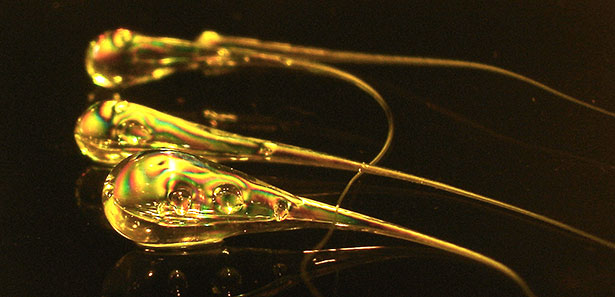Exposed: Secret of Prince Rupert's Drop
Unusual behavior of glass drop has puzzled scientists over 400 years.
Undestroyable and fragile all at once: The strange behavior of the teardrop-shaped glass drop has even stunned English kings, because the head of the teardrop resists even hits of a hammer, but they crumble immediately if you break the spiky tail at the end. The secret of its sensitive tail has been exposed 20 years ago, but the reason for the stability of the head was unknown til now.

Glassy drops with unusual behavior: Rupert's drops resist hits by a hammer, but burst immediately if the tail is broken.If you let hot, liquid glass fall drop wise into cold water or oil, the glass freezes very fast and forms a teardrop like structure with a thick head and a long glass tail. The unusual behavior was already discovered in the early 17th century by Prince Ruprecht of the Rhine, an aristocrat being interested in natural science who even showed King Charles II five of these drops causing significant furors at court.
Explosive burst ...
Since 400 years this Rupert's drops are a curiosity.
Says Srinivasan Chandrasekar of the Purdue University.
Famous scientists and natural philosophers tried to expose the secret of this glass-teardrops.
While its head resists even strong hits by a hammer, it bursts instantly to glass powder, if the thin end is broken or cut off.
The secret that lies behind the explosive decay of the drops could be exposed by Chandrasekar and his colleagues about 20 years ago: Highspeed recordings show, that cutting off the tail produces tiny flaws spreading with a speed of 1.2 miles per second through the glass, thereby forking, which makes the glass burst faster than a black-powder explosion.
Puzzling impact resistance
It has been unclear til now, why the head of the glass drop is that extremely stable.
If you take a hammer and hit it on its head you realize that the drop is totally resistant against bursting.
Chandrasekar explains.
If put between two plates it can resist forces of 15,000 Newton, which corresponds to a weight of a bigger car.
Related physical processes could be demystified now. An imaging technique, which polarizes light and makes stress distribution in the glass visible, was crucial for this to work. With special algorithms one can reconstruct the load strength and distribution in every phase of the hit.
Built in pressure capsule

Stress distribution in the head of the glass, made visible by polarizing light
The recordings show, that the special structure of the glass drop is responsible for the head being that resistant, because the layers on the surface of the head produce strong compression forces when being hit, thereby holding the glass together even stronger. In this process the pressure can grow til 700 megapascal, according to scientists.
This all around working pressure capsule prevents the glass from getting flaws and forking. Thereby the head of the drop becomes as stable as steel, according to Chandrasekar and his colleagues. This strength comes from the abrupt cooling down in the water bath, because the surface gets cold faster than the inside, leading to something like a pressure bandage.
Source: Applied Physics Letters, 2017; doi: 10.1063/1.4971339

That is so cool. Science is awesome.
Yes indeed! Thanks for reading!
This post has received a 3.23 % upvote from @booster thanks to: @n3bul4.